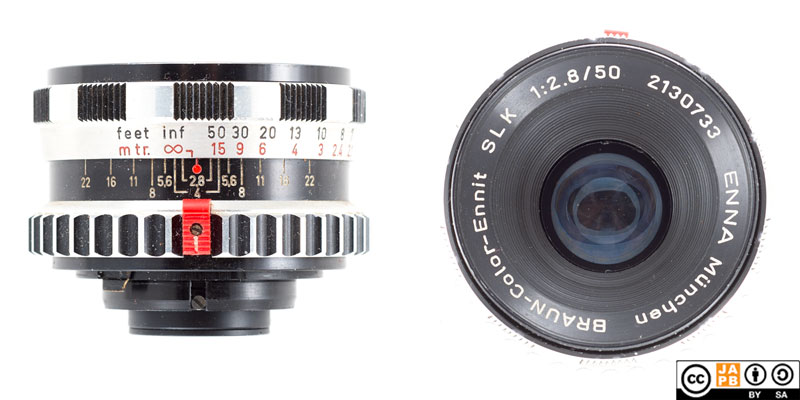Pekka Buttler, 04/2025

Specifications
The table below summarizes the lens’ key specifications (measurements based on pictured version of the lens):
| Brand: | ENNA München | Lens name | BRAUN-Color-Ennit SLK 1:2,8/50 |
| Focal length(s)1 | 50 mm | Angle-of-view2 | ≈46 ° |
| Maximum Aperture | f/2.8 | In Production | 1956–1962 |
| Lens mount (this lens) | SLK (BRAUN) | Other lens mounts | Other SLK |
| Length3 | 30,8 mm | Diameter4 | 52,7 mm |
| Filter ring diameter | 46 mm | Weight | 123 grams |
| Lens element count | 4 5 | Lens group count | 3 |
| Aperture blades (S/R/C)6 | 7 S | Focus throw | 170 ° |
| Minimum focusing distance (measured) | 1 m | Maximum magnification (estimated) | 1:18 |
| Has manual aperture ring | NO | Has Manual focus ring | YES |
| Aperture mechanism type | N/A | Aperture click stops | N/A |
Further notes:
• This lens was introduced as the budget fifty for The Braun Paxette Super III Automatic (ca. 1956). The Braun Paxette Super III Automatic and its sibling cameras (the Bolta Photavit 36, Bolta Photavit 36 Automatic, King Regula IIIc, King Regula IIId and King Regula IIId automatic) made up a new breed of West-German rangefinder cameras that shared an interchangeable lens mount built around a Prontor leaf shutter.
• This leaf shutter mount is sometimes called the Prontor-bayonet, but JAPB uses the name SLK, because each lens made for this mount contains the SLK acronym on its name ring.
• Due in part to the general unsuccessfulness of the SLK mount systems, adapting SLK mount lenses is a real challenge. See more in the JAPB article on the SLK mount.
Versions and variations
While ENNA München did have a relatively successful line of slow fifties (50/2.8 lenses, this lens included) there seems to not have been ‘Ennit’ named 50/2.8 lenses except for the various SLK mount cameras and (somewhat differing mounts notwithstanding) they seem to be practically identical.
History of ENNA München
ENNA München (also: Enna Werk München) is one of the 1950s and 60s most prominent and innovative German optics companies.
You can read more details in the ENNA München company profile.
Adapting the ENNA München BRAUN-Color-Ennit 50 mm f/2.8
Adapting SLK Lenses
Besides getting an original German 1950s rangefinder to utilise the lens in its native environment, the possibilities of using this lens are very limited … unless you can channel your inner Gyro Gearloose.
The heart of the matter is that there seem to be no ready-made adapters available for the SLK lens mounts anywhere, likely due mostly to the rather lacklustre sales success of the SLK systems and resulting low number of SLK lenses out there.Therefore one would have to manufacture their own – either through some 3D designing&printing or by cannibalising an original camera.
SLK lenses are (again) similar to DKL lenses in that they lack an aperture control ring of their own (as aperture was controlled on the camera. This means that any successful adapting of SLK lenses will necessitate an adapter that interacts with the lens aperture control lever on the lens to facilitate aperture manipulation, but otherwise the adapter
Footnotes
- Focal length is (unless stated otherwise) given in absolute terms, and not in Full-frame equivalent. For an understanding of whether the lens is wide/tele, see ‘Angle-of-view’. ↩︎
- Picture angle is given in degrees (based on manufacturers’ specs) and concerns the diagonal picture angle. Rule of thumb:
> 90 ° ==> Ultra-wide-angle
70–90 ° ==> Wide-angle
50–70 ° ==> Moderate wide-angle
40–50 ° ==> ‘Standard’ or ‘normal’ lens
20–40 ° ==> Short tele lens
10-20 ° ==> Tele lens
5-10 ° ==> Long tele lens
< 5 ° ==> Ultra-tele lens ↩︎ - Length is given from the mount flange to the front of lens at infinity. ↩︎
- Diameter excludes protrusions such as rabbit ears or stop-down levers. ↩︎
- Information on elements and groups is scarce. Even so, I will bet good money that the design of this lens is another Tessar (4 elements in 3 groups) derivative. ↩︎
- S=straight; R=rounded; C=(almost)circular at all apertures. ↩︎